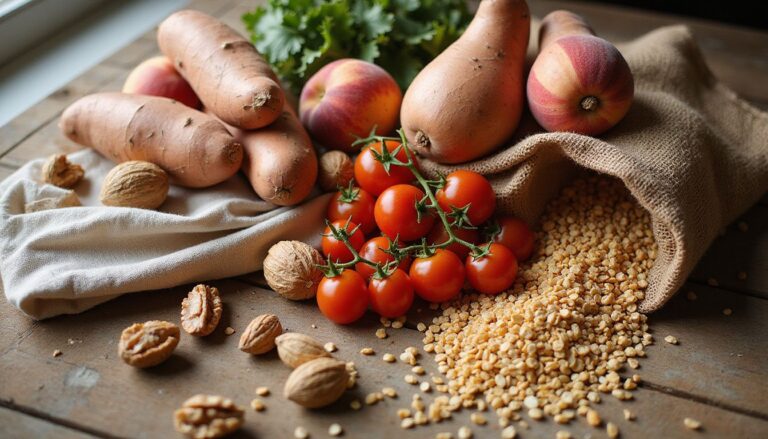Ideal Protein Diet: Your Ultimate Weight Loss Plan
Our Nutrition Assistant AI Suite will transform your body. You will lose fat, get toned, and build muscle. Gain confidence and optimal health.
If you have struggled to lose weight or keep it off, you are not alone. The Ideal Protein Diet uses a structured protocol to help you drop fat and build steadier habits. Its four phases aim to deliver early results, then teach you how to keep them.
This guide explains how the program works, the foods you can eat, what to expect, and how real people succeed. You will also see costs, research summaries, and a simple menu example. Use this to decide if a structured meal plan with health coaching fits your goals.
Key Takeaways
- The Ideal Protein Diet, launched in 2004 by Dr. Tran Tien Chanh, follows a strict four-phase, low-carb, high-protein plan with branded meal replacements for rapid weight loss.
- Clinical reviews, including a 2020 Journal of Obesity and Metabolic Syndrome paper, report average losses of 6 to 8 pounds in the first two weeks, then about 2 pounds per week.
- Phase 1 limits carbs to 20 to 30 grams per day, removes fruit, grains, and starchy vegetables, and includes daily supplements such as Multi-Vita, Potassium, Cal-Mag, and Omega-3.
- Required Ideal Protein products raise costs to about $16 per day, and many clinics charge extra for health coaching, sometimes up to $195 per session.
- The plan is not suitable for vegans, most vegetarians, or people with kidney disease; heavy use of ultra-processed foods may raise health risks per BMJ studies from 2018 and 2019.

What is the Ideal Protein Diet?

The Ideal Protein Diet is a structured weight loss program that limits carbohydrates and prioritizes quality protein foods. Its four phases aim to trigger fat loss first, then help you stabilize and maintain your progress.
What is the Ideal Protein Diet and how does it work?
Started in 2004 by Dr. Tran Tien Chanh and Olivier Benloulou, the plan uses a four-phase, low-carb protocol to encourage rapid fat loss. During early phases you cut sugars and starches, which can shift your body into ketosis, a state where fat becomes your main fuel.
Coaches guide your schedule, but they do not diagnose or treat medical issues. You rely on branded Ideal Protein foods plus specific vegetables, which keeps choices simple and controlled. The structure also aims to preserve lean muscle mass while calories are lower.
I found meal prep easier with a narrow, approved list and weekly check-ins that kept me on track.
Switching from carbs to quality protein made me feel more energetic each day.
Next, review the core principles that support steady results across the four phases.
What are the key principles of the Ideal Protein program?
The plan starts with strict carbohydrate limits to promote ketosis and improve metabolic health. In this state, your body uses stored fat for energy instead of carbs. Early phases depend on prepackaged Ideal Protein foods and lean protein sources, then shift back to more whole foods later.
Supplements, such as a multivitamin, omega-3, potassium, calcium, and magnesium, help cover nutrient gaps while intake is tightly controlled. You track protein, carbs, and fats to support fat loss while protecting muscle.
Many people notice less hunger on higher protein intake. Fruits and several vegetables are limited at first, then gradually reintroduced to add variety without losing control.
How does the diet promote ketosis and fat burning?
Phase 1 typically caps carbs at 20 to 30 grams per day. That steep drop burns through glycogen, your stored form of carbohydrate, so your body begins using fat, producing ketone bodies for fuel.
Most adults on the plan eat about 120 to 150 grams of protein daily to guard muscle mass. Full ketosis often develops within two to three weeks. The result is targeted fat loss with a lower chance of muscle loss.
How the Ideal Protein Diet Works
The Ideal Protein Diet uses four phases to move you from weight loss to maintenance. Think of it as training wheels that you gradually remove.
Phase 1: Weight Loss
Phase 1 focuses on rapid fat loss with structure and portion control. Most meals use Ideal Protein products plus select whole protein choices like chicken, fish, or eggs. Non-starchy vegetables, such as spinach, cucumbers, and broccoli, fill your plate.
Daily carbs stay under 20 to 30 grams to help trigger ketosis. A common dinner includes 4 to 6 ounces of uncooked lean protein and two cups of approved vegetables.
Supplements are required: IP Multi-Vita twice daily, IP Potassium once daily, IP Cal-Mag two tablets twice daily, and IP Omega-3 Plus one capsule twice daily. This routine aims for quick results while keeping hunger manageable.
Phase 2: Stabilization
After you reach your weight loss target or complete Phase 1, carbs return in a controlled way. The goal is to find a balanced mix of carbs, fats, and protein that you can live with.
Some fruits and vegetables come back in small servings. Coaching support continues to guide reintroduction and protect blood sugar stability. Careful planning made this step smoother for me, and the first serving of berries felt like a win.
Many people benefit from advice from a registered dietitian during this step, especially if they manage type 2 diabetes or high blood pressure.
Phase 3: Maintenance
Phase 3 strengthens the habits that prevent weight regain. You keep a steady balance of protein, carbs, and healthy fats. Tracking tools, like a food journal or an app, can help you spot patterns and stay consistent.
I used an app to watch my carb and fat intake, which kept me accountable day to day. Ongoing support from a coach or community often improves long-term success.
Phase 4: Lifestyle
Phase 4 supports lifelong habits and a stable weight. Your macronutrient targets may shift based on personal risk factors, such as high blood pressure, metabolic syndrome, or heart disease.
Many people find mindful eating gets easier with practice. You return to a wider range of fresh proteins and vegetables with moderate carbs. Limiting sugary drinks and ultra-processed foods helps protect your heart and maintain results.
What are the Benefits of the Ideal Protein Diet?
The plan is structured for rapid results. Coaching and clear rules remove guesswork, which helps many people stick with it.
How does the diet support rapid weight loss?
The Ideal Protein Diet pairs low carbs with high protein to encourage ketosis. In ketosis your body uses fat, not glucose from carbs, as its main fuel. Reviews in the Journal of Obesity and Metabolic Syndrome suggest 6 to 8 pounds lost in two weeks, then around 2 pounds per week.
Prepackaged meals control macros and portions, which supports steady progress. A 2022 JAMA Network Open analysis found commercial programs with coaching often beat do-it-yourself dieting for early weight loss.
How does high protein intake reduce hunger?
Protein helps you feel full longer by slowing digestion and steadying blood sugar. Eating 120 to 150 grams of protein a day can also protect your muscles during calorie cuts.
Including chicken, fish, eggs, dairy, or Ideal Protein products at meals reduces between-meal cravings. During my own cut, a higher protein target stopped my late-night snacking.
How does the diet improve blood sugar regulation?
Lowering carbs and total calories often improves blood sugar, especially in prediabetes or type 2 diabetes. Research reviewed in The Lancet in 2022 shows weight loss can reduce A1C, a key marker of blood sugar control.
Meals center on lean proteins and vegetables that digest slowly. This steadier pattern supports insulin sensitivity and avoids the spikes seen with sugary drinks and refined snacks.
What is the structure and phases of the program?
The program includes four steps: Weight Loss, Stabilization, Maintenance, and Lifestyle. Early stages use strict low-carb meals and required supplements. Later stages reintroduce carbs and build daily habits that keep your weight steady.
Coaching runs through every stage so you have guidance and accountability. Clear food lists and set rules simplify choices for meals and snacks.
What are the Challenges of the Ideal Protein Diet?
The plan is strict in early phases, and it depends on branded foods. That can feel limiting or expensive for some people.
Why is the diet considered restrictive in food choices?
Phase 1 removes fruit, grains, and starchy vegetables, even though these foods contain valuable nutrients. Many plant-based proteins, like beans and lentils, are discouraged. You rely on a short list of vegetables and specific protein sources.
These limits support ketosis, but they reduce variety. If you enjoy bananas, potatoes, or brown rice, you will avoid them in the first phase.
What is the role of pre-packaged products in the diet?
Ideal Protein products are central to Phases 1 and 2. Shakes, soups, bars, and chips deliver set amounts of protein, carbs, and fats. This control makes ketosis easier to reach and maintain.
Daily supplements, such as multivitamins, omega-3, Cal-Mag, and potassium, are also required. Although the structure can be helpful, people who prefer cooking from scratch may find it limiting.
What potential side effects should you expect?
Headaches, fatigue, and constipation can show up at first. People with kidney disease face extra risks with high protein intake, as reported by the Journal of the American Society of Nephrology in 2020.
The plan includes many ultra-processed foods, which BMJ studies in 2018 and 2019 linked with higher risks of cardiovascular disease and breast cancer. Restrictive phases may also lead to vitamin or mineral gaps. My first week brought constipation until I increased vegetables and water.
Those on medications or with health conditions should talk with a clinician before starting any strict diet.
Is the diet suitable for all dietary preferences?
The plan does not support a vegan pattern and offers limited vegetarian choices. It leans on animal proteins and branded products. Some research in Obesity Reviews in 2022 shows vegan diets can support weight loss and better diabetes markers, though the Ideal Protein approach differs.
If you avoid animal products due to beliefs or health needs, this program will be hard to follow. People with specific conditions, such as kidney disease or a recent bariatric surgery, should seek medical advice first.
Comparing the Ideal Protein Diet with Other Diets
Comparing plans helps you find a method you can actually live with.
Ideal Protein Diet vs. Ketogenic Diet
Ideal Protein uses branded foods to control portions and macros with coaching support. Classic keto allows wider whole-food choices as long as you hit macro targets, often about 60 percent of calories from fat.
Ideal Protein is lower in fat than keto and centers on lean protein with tight carb limits. Keto is more flexible, but offers less day-to-day guidance. I found Ideal Protein’s prepackaged options removed guesswork, which helped during busy weeks.
Next, see how Ideal Protein compares with the Paleo Diet on food variety and structure.
Ideal Protein Diet vs. Paleo Diet
Paleo focuses on whole foods like meat, fish, eggs, vegetables, fruits, nuts, and seeds. Processed items are off the table. Ideal Protein, in contrast, relies on packaged meals to drive ketosis quickly, especially in Phase 1.
Ideal Protein requires supplements, while Paleo usually does not. In my four-week tests, Paleo fit home cooking well but offered fewer quick options. The Ideal Protein plan provided structure and regular check-ins, which helped me stick with it.
What Foods Are Allowed on the Ideal Protein Diet?
The program lists approved options for each phase. Choosing from this list makes planning easier and supports your goals.
What protein sources are approved?
Approved seafood includes salmon, tuna, cod, shrimp, crab, and other white fish. Lean meats include flank steak, sirloin, and other trimmed beef cuts. Skinless chicken and turkey are allowed. Eggs and tofu are included. Pork tenderloin and lean ham are options, and some wild game is allowed.
During Phase 1 you prepare 4 to 6 ounces of whole protein for dinner before cooking. Sticking to measured portions supports steady progress and helps manage hunger.
Which vegetables and raw vegetables can you eat?
Unlimited raw vegetables include arugula, mushrooms, spinach, bok choy, lettuce, endive, and celery. Select vegetables, such as bell peppers, broccoli, chard, zucchini, asparagus, fennel, yellow squash, and radishes, are limited to four cups per day.
Occasional vegetables, including Brussels sprouts, green beans, eggplant, hearts of palm, jicama, leeks, rutabaga, snow peas, spaghetti squash, tomatillo, and tomatoes, are capped at four cups per week. You may use two teaspoons of permitted oils per day, such as olive or avocado oil, plus approved seasonings.
Adding variety kept my meals interesting, which made the plan easier to sustain.
What packaged Ideal Protein products are available?
The company offers shakes like the Ready-to-Serve Caramel Coffee Shake, plus bars, soups, chips, and other snacks. These products are portioned to control calories and macros and are required to participate in the program.
Labels list full nutrition facts so you can track intake. The lineup covers breakfast, snacks, and sweet options that fit the plan’s rules.
What Foods Should You Avoid on the Ideal Protein Diet?
Avoiding certain foods helps you reach ketosis and stay there. Skipping these items protects your early progress.
Which high-carb foods are off-limits?
Avoid rice, pasta that is not Ideal Protein branded, beans and lentils, bread, and cereal such as oats or granola. All fruit is also off-limits in Phase 1. These foods are high in carbs and can slow fat burning.
Many people find these limits tough at first. Most adjust within a couple of weeks as energy steadies.
Why avoid sugary snacks and drinks?
Sugary items cause quick blood sugar spikes, then energy crashes. That cycle drives hunger and cravings. Cutting juice, soda, candy, chocolate bars, and chips helps keep energy steady.
I once thought a small glass of orange juice was harmless. One cup has about 23 grams of sugar, which adds up fast. Switching to water or herbal tea made a clear difference in how I felt.
What fruits and starchy vegetables should be avoided?
Skip all fruit and starchy vegetables like corn, peas, carrots, beets, potatoes, and winter squash during Phase 1. These choices raise carb intake and can interfere with ketosis.
Fruit and vegetable juices also concentrate sugars. Avoiding them helps speed fat loss and steadies blood sugar.
What Does a Sample 7-Day Menu Plan for Phase 1 Look Like?
A simple structure makes Phase 1 easier to follow. The outline below shows a typical day you can repeat across the week.
What are the meals for each day?
- Breakfast: one Ideal Protein food, one Multi-Vita, one Potassium, and coffee or tea with up to one ounce of milk.
- Lunch: one Ideal Protein food, two cups of select vegetables, one Multi-Vita, and one Omega-3 Plus capsule; more select vegetables if desired.
- Dinner: 4 to 6 ounces of whole protein like chicken or fish, two cups of select vegetables, two Cal-Mag tablets, and one Omega-3 Plus capsule; extra vegetables if desired.
- Snack: one Ideal Protein food and two Cal-Mag tablets later in the day.
- Supplements: take all required supplements each day to support nutrition during weight loss.
- Restrictions: no fruit or starchy vegetables in this phase to promote ketosis.
- Hydration: drink plenty of water throughout the day and keep meal timing consistent.
This pattern helps curb hunger, supports blood sugar control, and lays the groundwork for long-term habits.
What snacks and supplements can you include?
Allowed snacks include Ideal Protein bars, chips, crispy puffs, and puddings. Raw vegetables like celery, cucumbers, and bell peppers make handy add-ons between meals. Aim for at least 64 ounces of water daily.
Required supplements: 2 IP Multi-Vita per day, 1 IP Potassium daily, 2 IP Cal-Mag twice a day, and 1 IP Omega-3 Plus twice a day. Permitted oils are limited to 2 teaspoons per day, and salt should follow your coach’s guidance.
What Are the Pricing and Costs of the Ideal Protein Diet?
Costs include food, supplements, and coaching. Planning your budget upfront prevents surprises later.
What are the costs for food and supplements?
Expect about $16 per day in North America for Ideal Protein foods and supplements. That is roughly $448 to $496 per month. Many clinics also require a starter kit with various meals and snacks.
Swapping in generic products is not allowed. Some find the structure reduces outside spending on takeout, while others see cost as a main barrier. Review coaching fees next to understand the full commitment.
What additional expenses, such as coaching, should you expect?
Health coaching, which is required at many clinics, can reach $195 per session in Central Texas. Not all coaches are Registered Dietitian Nutritionists, though many offer helpful accountability and support.
Extra services, like special events or one-on-one sessions, may add to your total. Coaching helped me stay motivated, but it did increase my monthly spend.
What Does Scientific Research Say About the Ideal Protein Diet?
Studies suggest structured, high-protein, low-carb plans can work well for short-term weight loss. Results vary over time, and long-term data are still developing.
What studies support weight loss outcomes?
A 2020 review in the Journal of Obesity and Metabolic Syndrome found high-protein and low-carb plans can be safe and effective for early weight loss. An April 2020 BMJ study also showed weight loss and better blood pressure within the first year.
My own results improved when I used a clear plan and tracked meals. Evidence-backed structure made daily decisions easier.
How does the diet affect blood sugar and cardiovascular health?
High-protein, low-carb diets can improve glucose control for people with obesity or type 2 diabetes, according to a May 2019 review in Nutrients. Many participants report fewer cravings and steadier energy when sugar intake is lower.
Heavy reliance on ultra-processed foods may carry health risks, as shown in BMJ studies from 2018 and 2019. Animal protein has been linked to a higher risk of type 2 diabetes in some research, including Diabetes Care in 2009. Adding more plant proteins and a range of vegetables supports a healthier heart profile.
How Do You Get Started on the Ideal Protein Diet?
Enrollment usually begins with a consultation and a health review. A short intake process prepares you for Phase 1.
How do you check if you are eligible?
Schedule a meeting with a clinician or registered dietitian. Share medical conditions, such as kidney or liver disease, and all current medications. The team will review your history, labs, and preferences to ensure the plan fits your needs.
If you eat vegan or mostly vegetarian, this plan is unlikely to match your routine. During my screening, I covered allergies, family history, and past diet attempts. That step made the path forward much clearer.
What happens during a meeting with a health coach?
You will discuss goals, routines, and meal planning. The coach explains approved foods, how to track progress, and how check-ins work. Expect regular weigh-ins and reviews of your food journal.
Coaches offer accountability and motivation, but they do not provide medical care. Meeting with a coach kept me focused and honest, which helped me follow the plan.
How do you design your personalized plan?
Work with a certified Ideal Protein coach to set targets and plan meals. Clinicians may adjust macros if you have prediabetes, type 2 diabetes, or other risks.
You start in Phase 1 with Ideal Protein foods and approved vegetables. Later, your coach will shift your carb, protein, and fat intake to maintain results. Weekly check-ins helped me avoid plateaus; small tweaks made a big difference.
What Are Some Success Stories and Testimonials?
Many people report quick early results, then steady progress through the maintenance phases. These stories can boost confidence as you begin.
What real-life weight loss achievements have been reported?
Ideal Protein highlights dieters who lose 6 to 8 pounds in the first two weeks of Phase 1, then about 2 pounds per week. Some report losing 30, 40, or even 100 pounds over several months, then keeping it off with continued support.
The mix of coaching, structure, and clear food rules helps many people form stronger habits.
What motivational experiences do participants share?
Participants often feel fuller longer and notice fewer cravings. Stable blood sugar makes it easier to focus. Regular check-ins, online groups, and progress tracking add accountability and keep motivation high.
Group challenges and shared recipes can make the process more enjoyable. Seeing steady progress over time keeps people engaged.
Frequently Asked Questions
These quick answers address common concerns before you start.
Is the Ideal Protein Diet safe for everyone?
People with kidney or liver problems should avoid high protein plans, as noted by the Journal of the American Society of Nephrology in 2020. Supplements in this program are not regulated like prescription drugs. Long-term outcomes vary, and reliable evidence is still growing.
Discuss your health history with a professional before you begin. I shared my plan with my clinician first, which helped me understand benefits and risks.
Can you exercise while on this diet?
Yes. Light to moderate activity, such as brisk walking or cycling, usually pairs well with early ketosis. Higher protein intake supports muscles while calories are reduced.
Structured meals provide predictable energy. Many people find that regular movement improves results and mood.
What happens after reaching your goal weight?
After you hit your goal, you move into Stabilization. Your coach helps raise calories carefully and guide carb reintroduction while you hold your new weight. Tracking food choices and portions is key in this stage.
Then you enter Maintenance and, finally, Lifestyle. Ongoing coaching and routine check-ins reduce weight regain, and many people feel more confident making balanced choices day to day.
What Resources Are Available for the Ideal Protein Diet?
Good tools make the plan easier. A few smart picks can boost consistency and keep meals interesting.
What are the best apps and websites for support?
Fooducate grades foods and explains nutrition labels. My Macros+ tracks protein, carbs, and fats with helpful charts. Obesity.org and Eatright.org can connect you with registered dietitian nutritionists for expert guidance.
Where can you find recipe ideas for variety?
Browse the Ideal Protein Library for options like Oven Roasted Brussels Sprouts Benedict with Herb Dressing and Oven Roasted Lemon Dill Salmon on Riced Cauliflower. These choices fit program rules and add flavor.
MyPlate.gov also offers budget-friendly recipes built around lean protein and vegetables. I enjoyed their chicken and vegetable stir-fry, which kept me full longer than my usual meals.
How do you find a registered dietitian?
Use the “find a registered dietitian” tool on Eatright.org to search by location and specialty. A registered dietitian can tailor advice to your goals and medical history.
I found my nutrition coach there during Phase 1, which boosted my confidence and improved my weekly plan adjustments.
Conclusion
The Ideal Protein Diet offers a clear, four-phase path to lose weight, then maintain it. You focus on high-protein meals, strict carb limits, and steady support from a coach. Clinical reviews show that structured programs often deliver faster early results than going it alone.
This plan is restrictive, especially early, and it carries real costs. It also may not fit plant-forward eaters or those with kidney disease. Talk with a clinician if you have medical conditions or take prescriptions.
If you want a structured weight loss program with defined steps, coaching, and a simple food list, Ideal Protein provides an organized way forward. Use the phases, track your progress, and build habits that last.
FAQs
1. What is the Ideal Protein Diet and how does it work for weight loss?
The Ideal Protein Diet is a structured meal plan that limits carbohydrates and emphasizes high-quality protein. This approach helps the body burn stored fat for energy, which can lead to steady weight loss. Clinical studies show that low-carb, high-protein diets may support fat loss while preserving lean muscle mass.
2. What foods are allowed on the Ideal Protein Diet?
The plan includes lean meats, fish, eggs, and certain vegetables. Processed grains, sugary snacks, and starchy vegetables are restricted. The diet uses specially formulated meal replacements to ensure balanced nutrition and portion control.
3. Are there any risks or side effects with the Ideal Protein Diet?
Some people may experience fatigue, headaches, or constipation during the first week as their bodies adjust to fewer carbohydrates. Medical professionals recommend regular monitoring to ensure safety, especially for those with health conditions such as diabetes or kidney disease.
4. How effective is the Ideal Protein Diet for long-term weight management?
Research indicates that structured high-protein diets can help with initial weight loss and may support long-term maintenance if combined with ongoing lifestyle changes. Personal experience shows that regular coaching and education about nutrition increase the chances of keeping weight off after reaching a goal.
Summary:
The Ideal Protein Diet uses a low-carb, high-protein approach to promote fat loss while maintaining muscle. It restricts certain foods but provides balanced nutrition through meal replacements. While some side effects may occur, medical guidance helps ensure safety. Studies suggest this diet can be effective for both short- and long-term weight management when paired with healthy habits.







